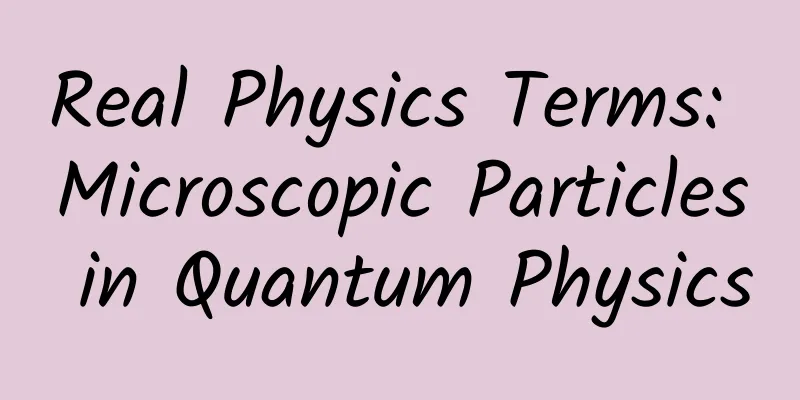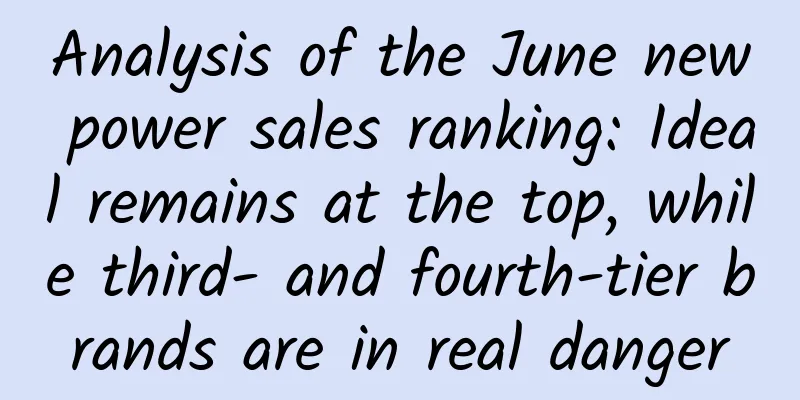Real Physics Terms: Microscopic Particles in Quantum Physics

|
When creating proper nouns, one principle is to reveal the essence of things or point out their most important characteristics. When new things first appear, scientists name them according to their understanding at the time. However, with the continuous development of science, in some cases, the initial understanding may not be correct, and the nouns used are prone to misinterpretation. But since the nouns have been widely used, it is not easy to change them. The author will "nitpick" some important nouns in physics, carefully study their meanings, and explore the profound physical meanings behind them. --author Written by Chen Shaohao (Massachusetts Institute of Technology, USA) Quantum mechanics is one of the greatest achievements of physics in the 20th century. There are many concepts in quantum mechanics that do not exist in classical physics, and some even go against people's intuition. However, it is the introduction of these seemingly strange concepts that can accurately and effectively explain the experimental phenomena in the microscopic world. On the basis of quantum mechanics, physicists further developed quantum field theory. In modern physics, quantum field theory has become the basic theory for describing microscopic particles. Many concepts in quantum physics are far from what people see and hear in daily life, and it is not easy to describe these concepts with appropriate terms. Based on quantum mechanics and quantum field theory, this article will examine some physical terms related to microscopic particles and explore their physical meanings. Atoms can be split Macroscopic objects that we see in daily life are made up of atoms or molecules. In the early 19th century, chemist Dalton established the atomic theory, which holds that the smallest unit of the material world is the atom, and that atoms remain unchanged during chemical changes. Molecules are formed by multiple atoms bonded together by chemical bonds. The essence of a chemical reaction is that molecules decompose into atoms and then recombine into new molecules. The English word for atom is Atom, which comes from Greek and originally means single and indivisible. The Chinese word "原" is a pictographic character, which originally means the source of water flow, and later it was written as "源". The abstract meaning of the word "原" is the first and original, referring to the beginning or root of things, or the original things. For example, raw material means something that has not been changed by humans. The Chinese word "核" and the English word "Atom" are consistent in meaning. In the 20th century, with the development of modern physics experiments and theories, physicists discovered that atoms have internal structures and can be divided. Atoms are composed of nuclei and electrons, with the nucleus at the center and the electrons distributed around the nucleus. Although the physical meaning of atoms has changed, the word "Atom" in English and "Atom" in Chinese has long been widely used, so it has been used forever. Elementary particles are indivisible and have no shape The nucleus of an atom can also be divided. The nucleus of an atom is made up of protons and neutrons. Protons and neutrons can be further divided, and they are made up of quarks. Quarks and electrons are the most basic particles. The smallest or most basic unit that makes up matter is called an elementary particle. Elementary particles cannot be divided. Figure 1: The internal structure of an atom. An atom is made up of a nucleus and electrons. A nucleus is made up of protons and neutrons. Neutrons and protons are made up of quarks. According to quantum statistical theory, elementary particles can be divided into two categories: fermions and bosons. The spin of fermions is half-integer, while the spin of bosons is integer, named after physicists Fermi and Bose respectively (spin is an intrinsic property of elementary particles, which will be discussed later). According to the Standard Model of particle physics, everything in the world is composed of three generations of basic fermions. For example, quarks and leptons are the most basic fermions. Electrons are a type of lepton. The original meaning of quark in English is the cry of a seagull. Its discoverer Gell-Mann was inspired by literary works and named it with this word. Three quarks make up a baryon. Baryons are named because their mass is much larger than that of leptons. Protons and neutrons are both baryons. A quark and an antiquark make up a meson. The English word for meson, Meson, comes from the Greek word Mesos, which means middle. Its discoverer Hideki Yukawa named it Meson because the mass of mesons is between electrons and protons. There are four fundamental interactions in nature, from strong to weak: strong interaction, electromagnetic interaction, weak interaction and gravity. The fundamental particles that transmit these interactions are called "Gauge Bosons". "Boson" means that the spin is an integer, and "Gauge" is because it is related to Yang-Mills gauge field theory. For example, gluons are elementary particles that transmit strong interactions. The word "glue" vividly describes how strong interactions "stick" quarks together tightly, thus forming baryons or mesons. Baryons and mesons are therefore collectively called hadrons. Protons in the nucleus have positive charges, and there is electromagnetic repulsion between protons. It is through the transmission of strong interactions through gluons that protons can be "sticked" together. Photon is also a kind of elementary particle. Photon in English is Photon, which means light in Greek. In 1926, physical chemist Gilbert Lewis first used the word Photon to name the carrier of light. Later, this term was widely adopted by the academic community. Since light is an electromagnetic wave and the most common electromagnetic wave, the meaning of photon (i.e. Photon) has been further expanded, and physicists use it to name the elementary particles that transmit electromagnetic interactions. The word photon makes people intuitively think that it has particle properties. Photons do have particle properties, which is confirmed by the photoelectric effect experiment. However, photons also have wave properties, which is confirmed by Young's double-slit interference experiment. This wave property is not reflected in the word "photon". The author believes that naming the basic particles that transmit electromagnetic interactions "electromagnetic elements" can better reflect their physical meaning than "photons". The Chinese word "particle" easily reminds people of solid particles in the macroscopic world, and makes people intuitively think that particles have shapes. Some people may ask, what shape is an electron? What shape is a proton? Is it spherical? The answer is: elementary particles have no shape. The English word for particle is Particle, which means an indivisible basic unit. As for the shape of this basic unit, or even whether it has a shape, it has nothing to do with the meaning of the word Particle. According to quantum field theory, elementary particles are the smallest energy unit of quantum fields. This is an abstract concept, unlike macroscopic objects that have a specific shape. Therefore, translating Particle into "element" (i.e., basic energy unit) is more accurate than "particle". Atomic orbitals have no trajectory When many new things in the microscopic world were first discovered, people used to borrow existing terms from the familiar macroscopic world to name them. With the development of science, people gradually discovered that the essence of these things was inconsistent with the original understanding, and the original terms could not well describe their true meaning. A famous example is "atomic orbital". In the macroscopic world, objects move along a certain trajectory according to the laws of Newtonian mechanics. If this trajectory is certain, it is usually called an orbit. For example, the earth revolves around the sun, and its orbit is elliptical. In the microscopic world, the situation is different. For example, when electrons were first discovered, people believed that the movement of electrons had trajectories according to the common concept of classical mechanics. Just like the elliptical orbit of the earth revolving around the sun, electrons also revolve along an elliptical orbit around the nucleus. However, this model based on classical mechanics has serious flaws. It cannot explain why accelerated charged electrons do not radiate energy outward. After the establishment of quantum mechanics, electrons are described by wave functions, and the modulus of the wave function represents the probability of the electron appearing in space. The electrons in atoms are in a bound state, which is a quantum state in the microscopic world, different from the motion state of macroscopic objects. Bound electrons are distributed around the nucleus like a "cloud" and have no definite trajectory of motion. Taking hydrogen atoms as an example, the probability distribution of ground state electrons is spherical, and the probability distribution of first excited state electrons is dumbbell-shaped, which is completely different from the elliptical motion trajectory of classical objects. According to the uncertainty principle, the position and momentum of electrons cannot be measured at the same time, that is, the motion trajectory of electrons is uncertain and there is no motion orbit. It can be seen that it is inappropriate to describe the motion state of electrons with orbit. In 1932, chemist Robert Mulliken proposed to replace Orbit with Orbital. This proposal is widely accepted. In today's English textbooks and literature, Atomic Orbital is used to represent the motion state of electrons in atoms, abbreviated as Orbital. In Chinese literature, Atomic Orbital is generally still translated as atomic orbital. It is worth noting that the meanings of Orbital and Orbit are not the same. Orbit refers to the motion orbit of macroscopic objects in classical physics. Orbital was originally an adjective evolved from Orbit, and its original meaning refers to something related to orbit. However, when Orbital is used as a noun, it specifically refers to the atomic orbit in quantum mechanics. Its real meaning is the spatial distribution pattern of bound electrons, which is completely different from the classical motion orbit. The author believes that it is more reasonable to translate Orbital into "bound mode" than "orbit". Orbital can also be understood as an area where the probability of electrons appearing in space is relatively high, so some literature translates it as "orbital". Some literature translates Orbital as "track state", which means a quantum bound state. Unfortunately, these statements are not widely adopted. Figure 2: Electrons in the ground state of a hydrogen atom. Left: According to classical physics, an electron is a small ball that revolves around the nucleus along an elliptical orbit. This is an incorrect image. Right: According to quantum mechanics, electrons have no specific shape or definite trajectory, but are distributed around the nucleus like a "cloud" with spherical symmetry. This is a correct image. Since the term atomic orbital has been widely used in Chinese literature, this term will still be used below to avoid confusion. Electrons in atoms are described by orbital wave functions. Orbital wave functions are determined by three quantum numbers, namely the principal quantum number, angular quantum number, and magnetic quantum number, which represent the energy level, angular momentum, and orbital orientation of electrons, respectively. The angular momentum quantum numbers are 0, 1, 2, and 3, corresponding to s orbitals, p orbitals, d orbitals, and f orbitals, respectively. These names are derived from the description of the appearance of the characteristic spectral lines of atomic spectra, namely sharp spectrum, principal spectrum, diffuse spectrum, and fundamental spectrum. Spin is not rotation Another term borrowed from the macroscopic world to describe microscopic things is "spin." Spin is a concept in quantum mechanics that is easily misunderstood. In 1924, Pauli proposed the famous Pauli Exclusion Principle, which states that no two electrons can be in the same quantum state at the same time. In order to make this principle valid, Pauli introduced a new degree of freedom to electrons, called the "Two-valued Quantum Degree of Freedom". However, Pauli failed to explain what the physical reality of this "degree of freedom" is. In 1925, Kronig, Uhlenbeck and Goudsmit proposed that this degree of freedom corresponds to electron spin. According to the image of classical physics, the electron is imagined as a charged sphere, whose rotation has angular momentum and generates a magnetic field, thus explaining the experimental phenomenon of atomic energy level splitting in an external magnetic field. However, this explanation based on the rotation of macroscopic objects has a big problem. The rotation of a macroscopic object (also called spin in English) refers to the rotational motion relative to a certain axis of the object, such as the rotation of the earth. Later, with the further development of quantum mechanics, both theory and experiment believed that elementary particles (including electrons) are indivisible point particles without axes, so the rotation of macroscopic objects cannot be directly applied to the spin of microscopic particles. The spin of microscopic particles can only be explained by quantum mechanics. Quantum mechanics believes that spin, like mass and electric charge, is an intrinsic property of elementary particles. The operation rules of spin are similar to angular momentum in classical mechanics, and can also generate a magnetic field, but it is essentially different from the rotation in classical mechanics. Spin does not mean that the particle itself is "rotating", but rather an "intrinsic angular momentum" that the particle is born with. Intrinsic means that the value of spin depends only on the type of particle and cannot be changed by external forces. The value of spin is quantized and described by the spin quantum number. For example, the spin quantum number of an electron is 1/2, and the spin quantum number of a photon is 1. A concept similar to spin is isospin. Isospin is a quantum number related to strong interactions and is used to distinguish particles in different charge states, such as protons and neutrons. Isospin is a dimensionless physical quantity that does not have units of angular momentum, so it has nothing to do with rotation in classical physics. It is called "isospin" simply because its mathematical description is very similar to spin. About the Author Shaohao Chen holds a bachelor's degree in physics and a doctorate in atomic and molecular physics from Tsinghua University. He was a postdoctoral researcher at the University of Colorado Boulder, and has worked at Louisiana State University and Boston University. He is currently working at the Massachusetts Institute of Technology, engaged in high-performance computing. This article is supported by the Science Popularization China Starry Sky Project Produced by: China Association for Science and Technology Department of Science Popularization Producer: China Science and Technology Press Co., Ltd., Beijing Zhongke Xinghe Culture Media Co., Ltd. Special Tips 1. Go to the "Featured Column" at the bottom of the menu of the "Fanpu" WeChat public account to read a series of popular science articles on different topics. 2. Fanpu provides a function to search articles by month. Follow the official account and reply with the four-digit year + month, such as "1903", to get the article index for March 2019, and so on. Copyright statement: Personal forwarding is welcome. Any form of media or organization is not allowed to reprint or excerpt without authorization. For reprint authorization, please contact the backstage of the "Fanpu" WeChat public account. |
Recommend
Did Bai Juyi also suffer from depression? Is it the same as what we are talking about today?
Therefore, the verses written on the river bridge...
What to do if you accidentally lose your phone? It is crucial to do these things
Going out for a holiday, booking attractions, tak...
Why have we done so much but the seed users just don’t buy it?
Friends who are engaged in operations may have fe...
Some slightly more advanced uses of CocoaPods
[[150180]] I remember when I first started iOS de...
How to do “user operation”?
Let’s get down to earth and look at how “ user op...
A must-read for APP operators, 108 examples of marketing tactics!
Introduction: In the recent Double Eleven e-comme...
App operation: the most complete guide to launching APP products!
As an operator , the most basic work is to launch...
Why is the volume dropping? Five factors that make APP promotion difficult!
Many CP friends who do channel (especially third-p...
Breaking news! Positive matter can exist because of neutrinos, which reshuffle the positive and antimatter!
Scientific research continues to surprise, and no...
I have heard of "husband and wife look alike", but what the hell is "human-dog look alike"? !
According to a study by Weird Psychology author W...
How much does it cost to customize a pipe fittings applet in Bayinguoleng?
There is no doubt that the topic of mini programs...
Devoting himself to scientific research, he drew China's "agricultural map"
As a scientific worker, I must not stand idly by ...
How many degrees did Nezha need to melt the goddess Shiji? Scientific interpretation: At least this number!
Recently, the movie "Nezha: The Devil Boy Co...
Looking up at the night sky, the stars are bright and dim. How long does it take for the starlight to travel to our retinas?
How long it takes for starlight to reach our reti...
Liang Jinghong's Color Design Principles [HD]
Liang Jinghong's Color Design Principles [HD]...









